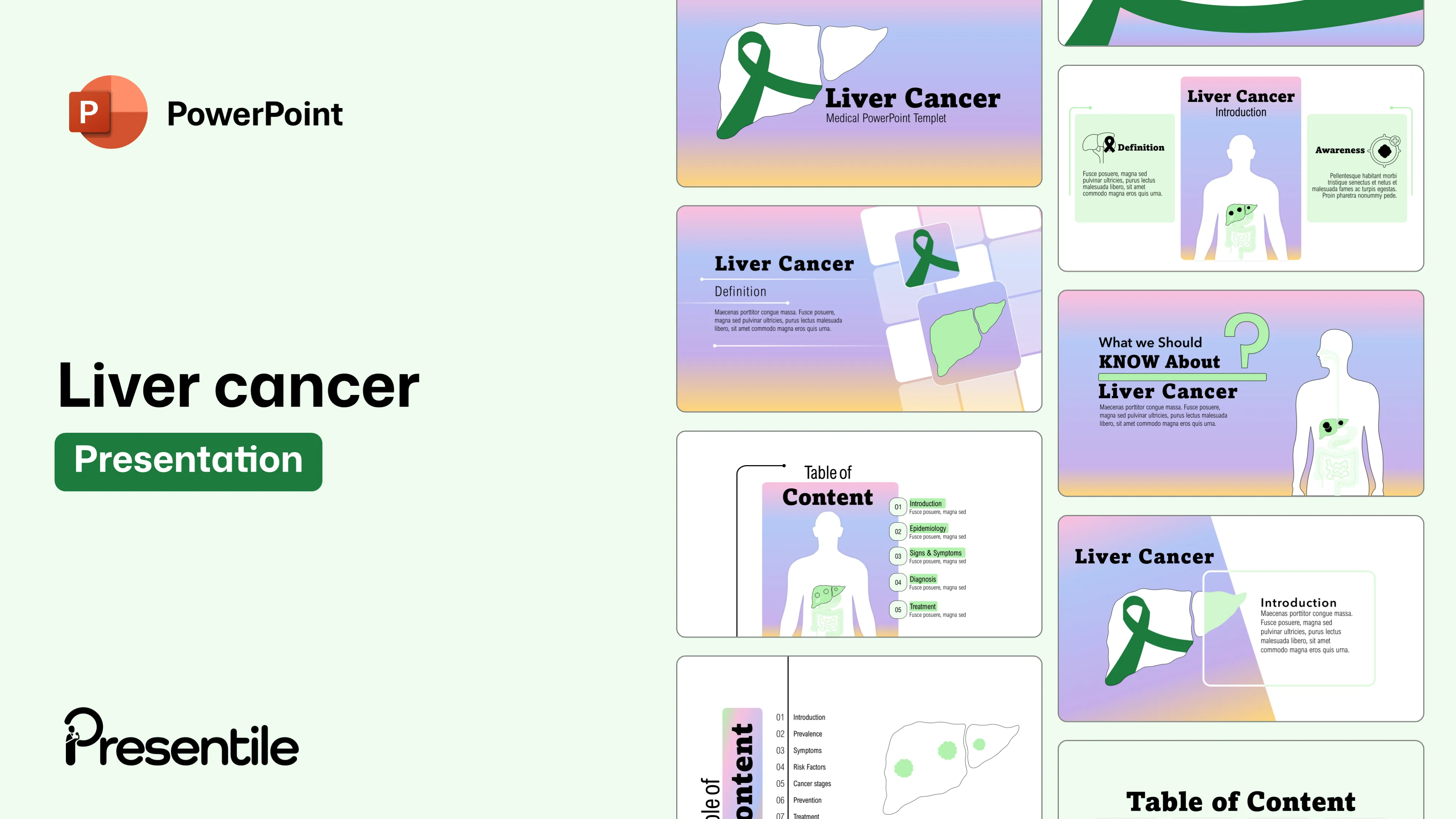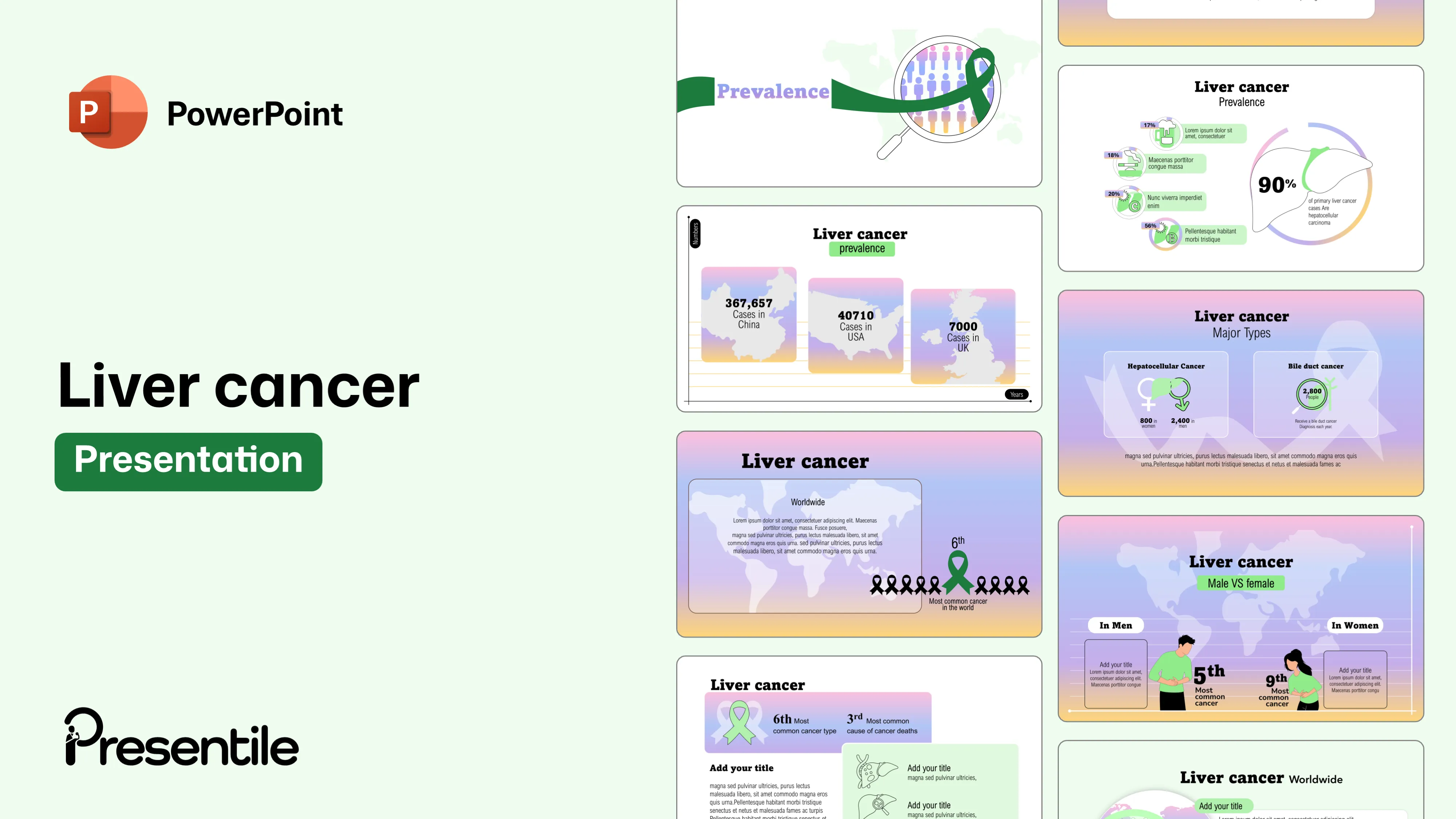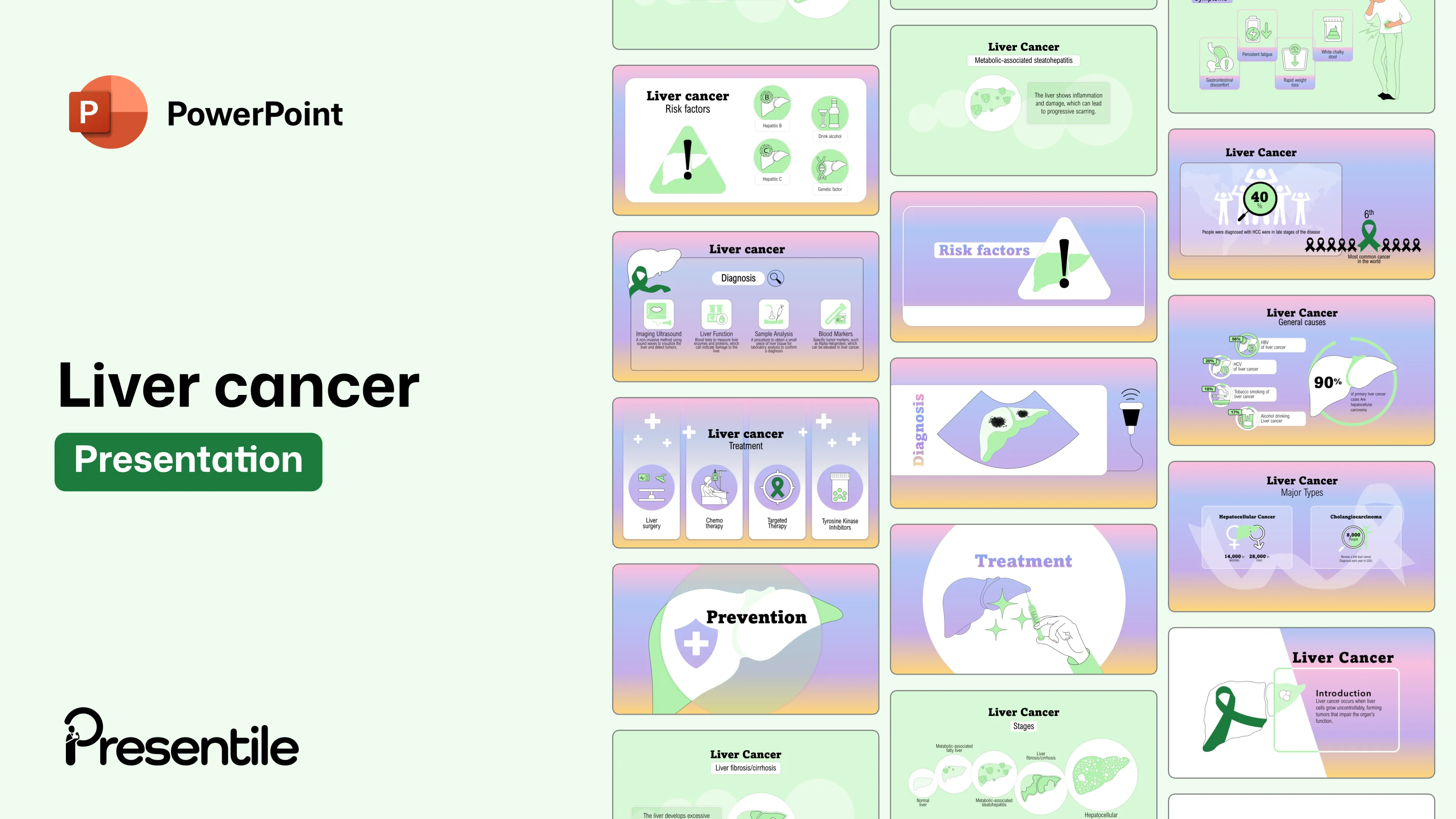
Content of
Liver Cancer Presentation
Slide 1: Liver Cancer - Title Slide
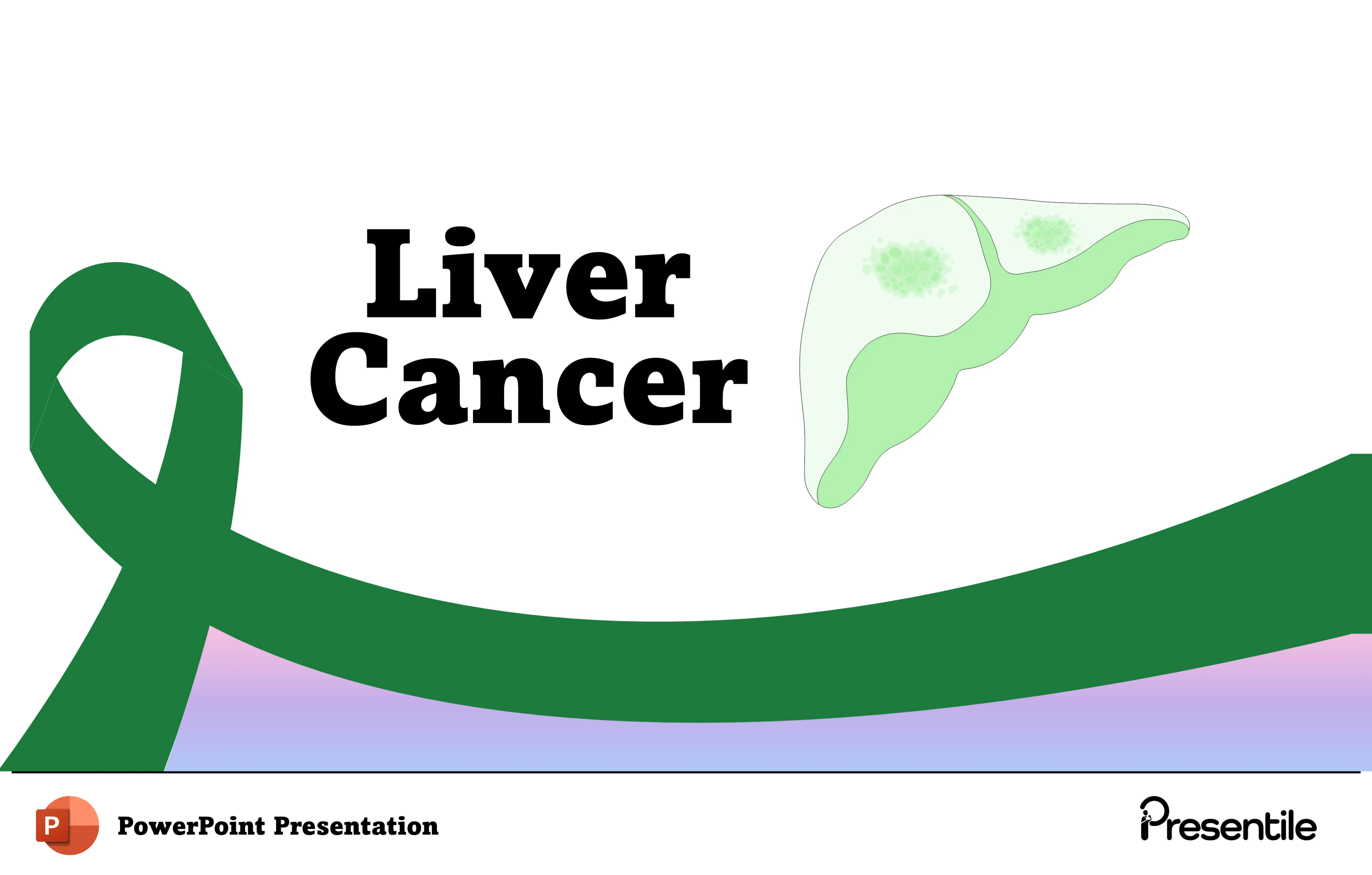
- This title slide provides a striking and professional introduction to the topic of Liver Cancer.
- Features a detailed illustration of the liver and a supportive awareness ribbon.
- This impactful visual not only sets a professional tone but also prepares the audience for a focused and insightful presentation right from the start.
Slide 2: Introduction to Liver Cancer
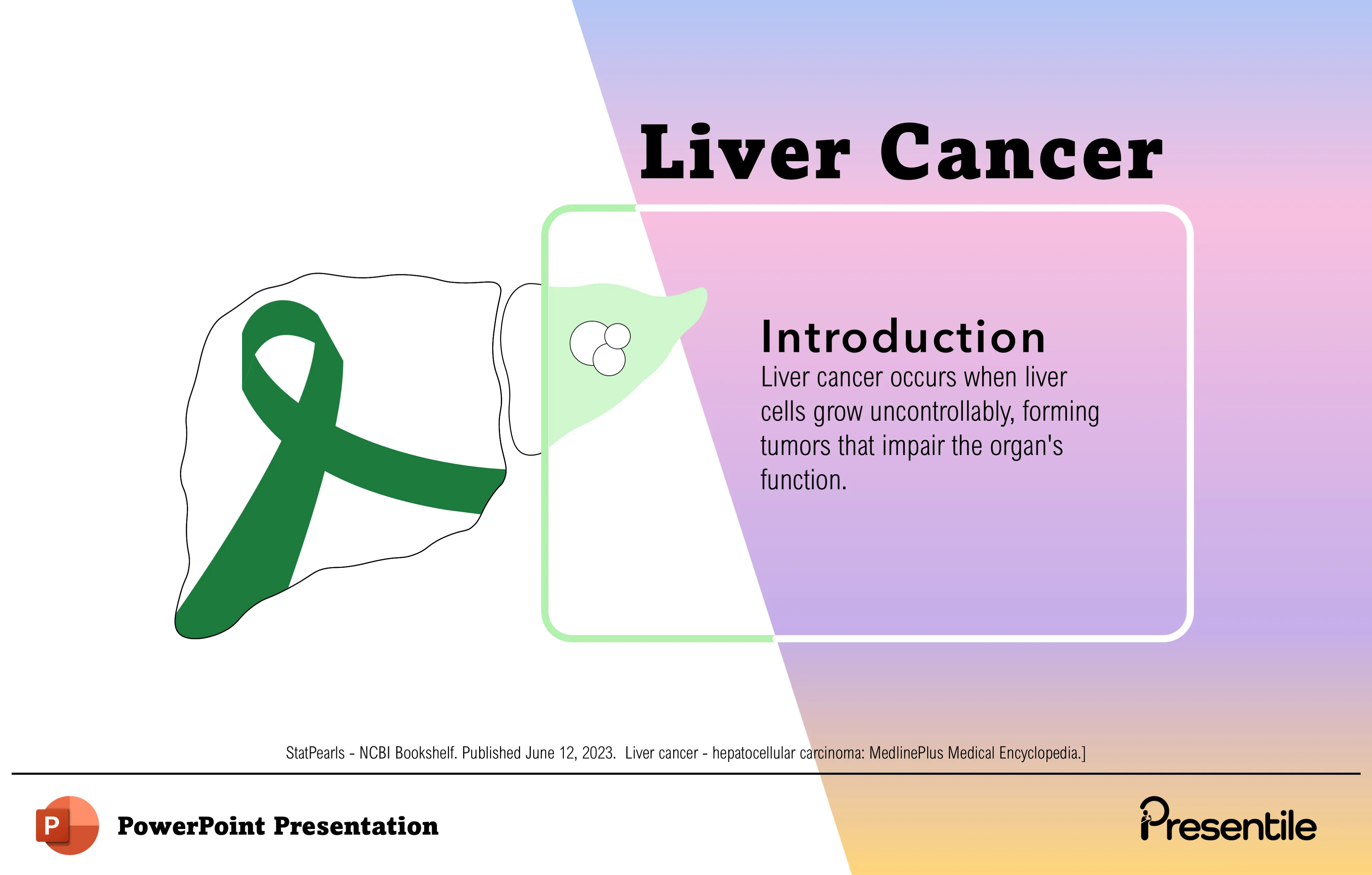
- Discover the basics of liver cancer, a serious condition marked by the uncontrolled growth of liver cells.
- This introduction explains how malignant tumors form in the liver and interfere with its vital functions.
- Our professionally designed slide—featuring a detailed liver diagram and an awareness ribbon—gives audiences a clear starting point before exploring complex topics. Perfect for healthcare professionals, educators, and medical presenters who want to communicate liver cancer fundamentals with clarity and impact.
Slide 3: Liver Cancer Epidemiology
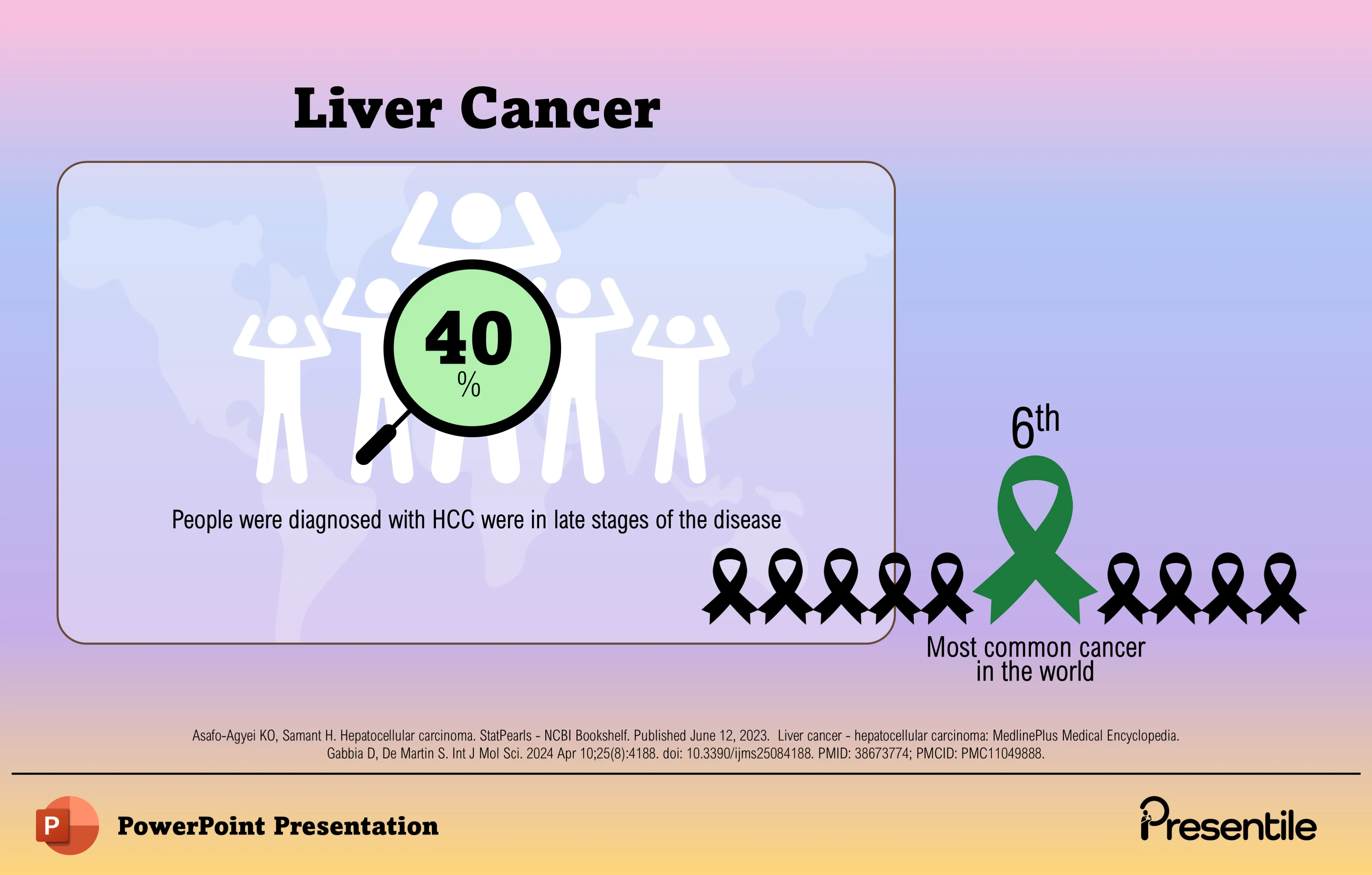
- Understand the global impact of liver cancer with this data-rich slide on its epidemiology.
- Ranked as the sixth most common cancer worldwide, liver cancer represents a major public health challenge.
- The slide highlights a key concern in treating hepatocellular carcinoma (HCC)—late diagnosis.
- Research shows that up to 40% of patients are diagnosed at advanced stages, when treatment options are limited.
- Featuring clear visuals and compelling statistics, this slide equips healthcare professionals, educators, and advocates with essential facts to emphasize the importance of early detection and screening.
Slide 4: General Causes and Types of Liver Cancer

- Gain a clear understanding of the main causes and types of liver cancer with this comprehensive slide.
- Hepatocellular carcinoma (HCC) is the dominant form, making up 90% of all primary liver cancer cases.
- The slide breaks down major risk factors: chronic Hepatitis B (56%), Hepatitis C (20%), tobacco smoking (18%), and alcohol consumption (17%).
- Featuring an engaging, data-driven visual, this resource helps healthcare professionals, educators, and public health advocates explain how chronic infections and lifestyle factors drive liver cancer and underscore the importance of vaccination and lifestyle management for prevention.
Slide 5: Major Types of Liver Cancer
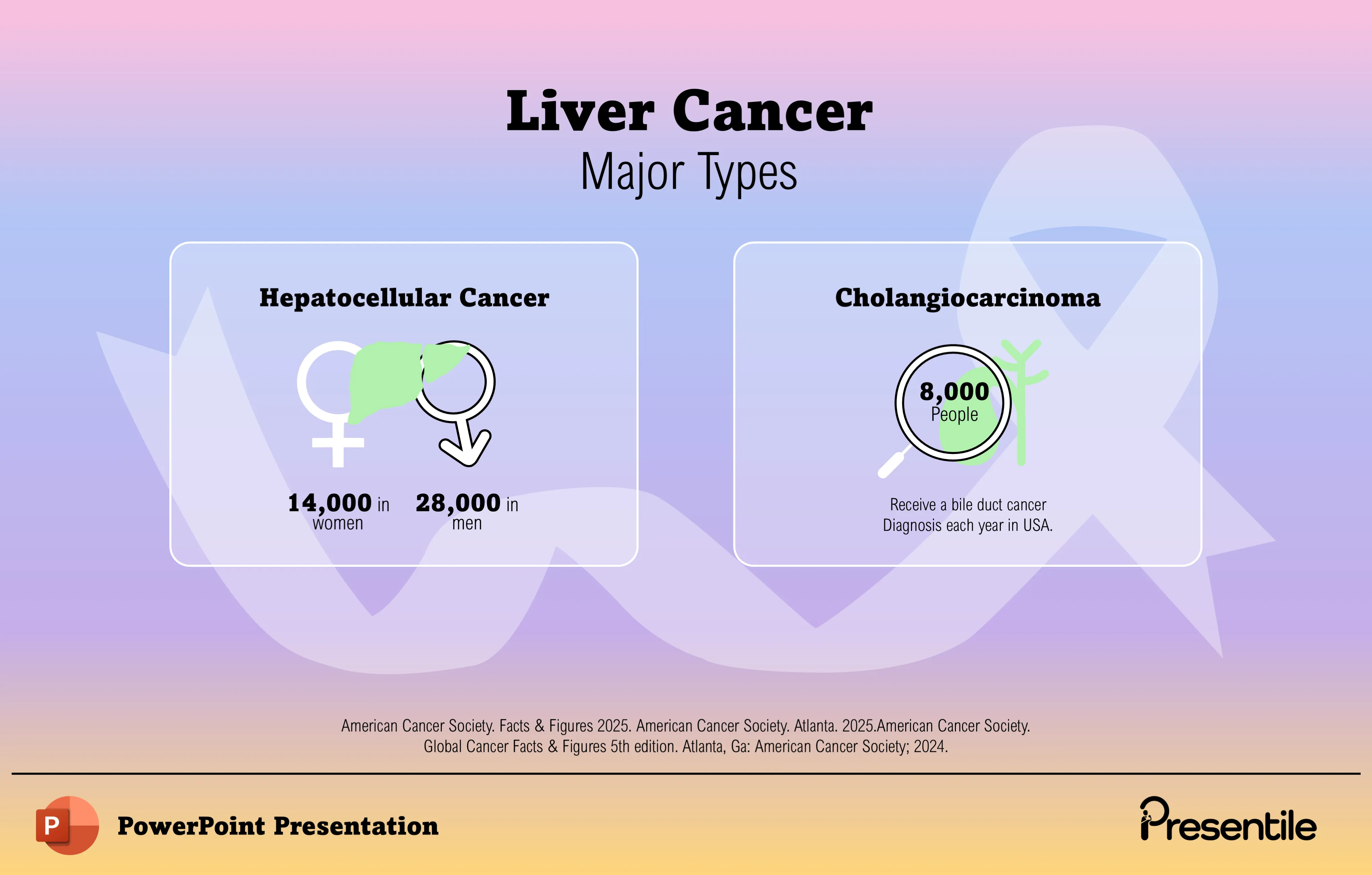
- This professionally designed PowerPoint slide delivers a clear, data-driven overview of the major types of liver cancer, including Hepatocellular Carcinoma (HCC) and Cholangiocarcinoma (bile duct cancer).
- It visually distinguishes HCC—diagnosed each year in approximately 14,000 women and 28,000 men, with higher incidence in men—from Cholangiocarcinoma, a less common yet clinically significant cancer affecting about 8,000 individuals annually in the U.S.
- This slide is ideal for medical presentations, helping healthcare professionals and educators explain liver cancer classifications, prevalence, and key epidemiological data with impact.
Slide 6: Clinical Symptoms of Liver Cancer

- This professionally designed PowerPoint slide offers a clear and concise overview of the clinical symptoms of liver cancer, presented in an organized, card-based layout for easy understanding.
- It highlights key signs such as gastrointestinal discomfort (including nausea and early satiety), persistent fatigue, rapid and unexplained weight loss, and pale or chalk-colored stools that may indicate bile duct obstruction.
Slide 7: The Stages of Liver Cancer
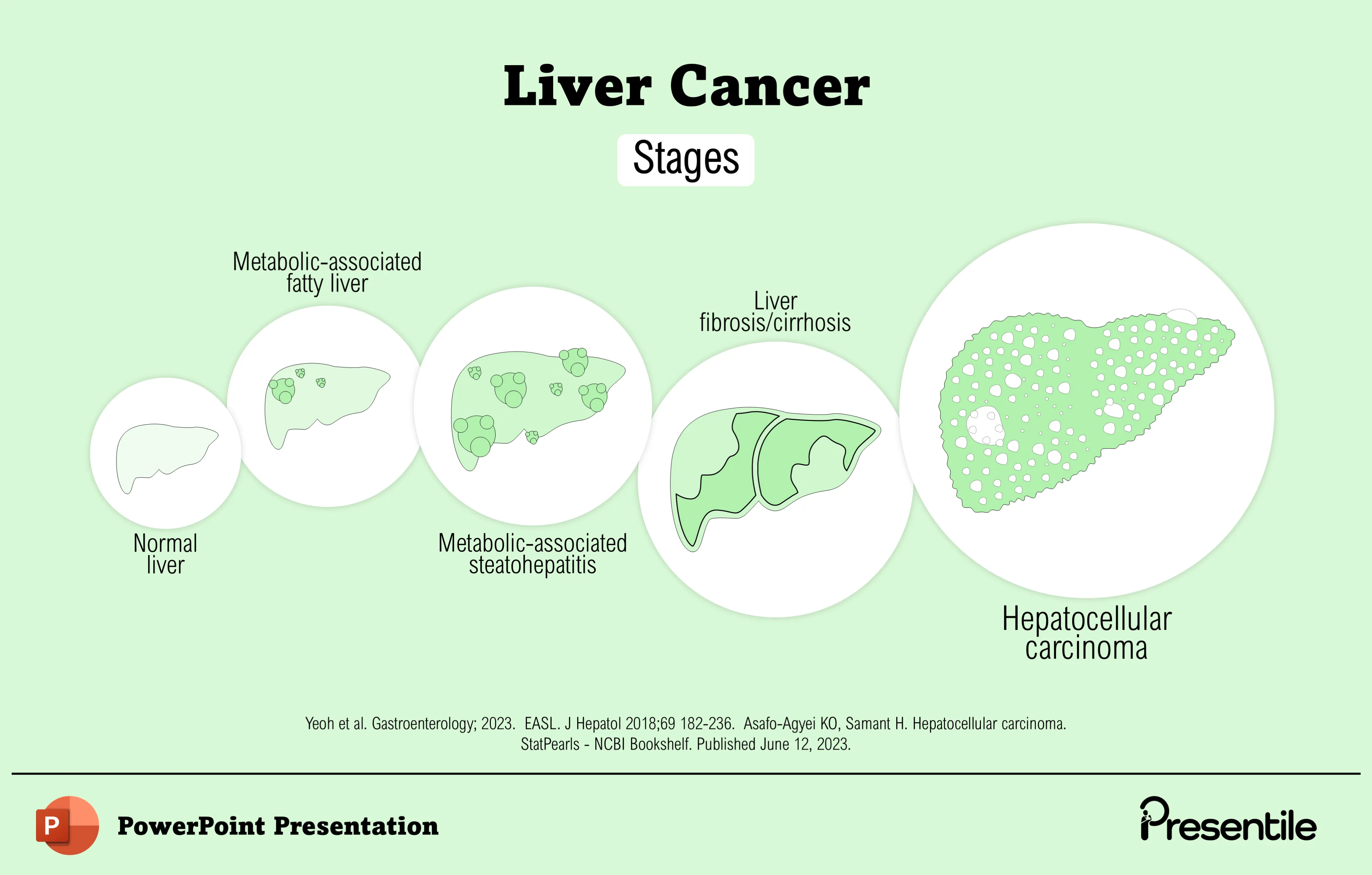
- This professionally designed PowerPoint slide presents a clear, progressive overview of the stages of liver cancer development, guiding viewers through the disease’s natural history.
- It visually transitions from a normal liver to metabolic-associated fatty liver disease, then to metabolic-associated steatohepatitis with inflammation and cellular injury, followed by fibrosis and advanced cirrhosis—the strongest risk factor for hepatocellular carcinoma.
- The final stage, hepatocellular carcinoma, is clearly illustrated to help healthcare professionals, educators, and students explain the underlying pathology and risk factors that lead to liver cancer.
Slide 8: Metabolic-Associated Fatty Liver
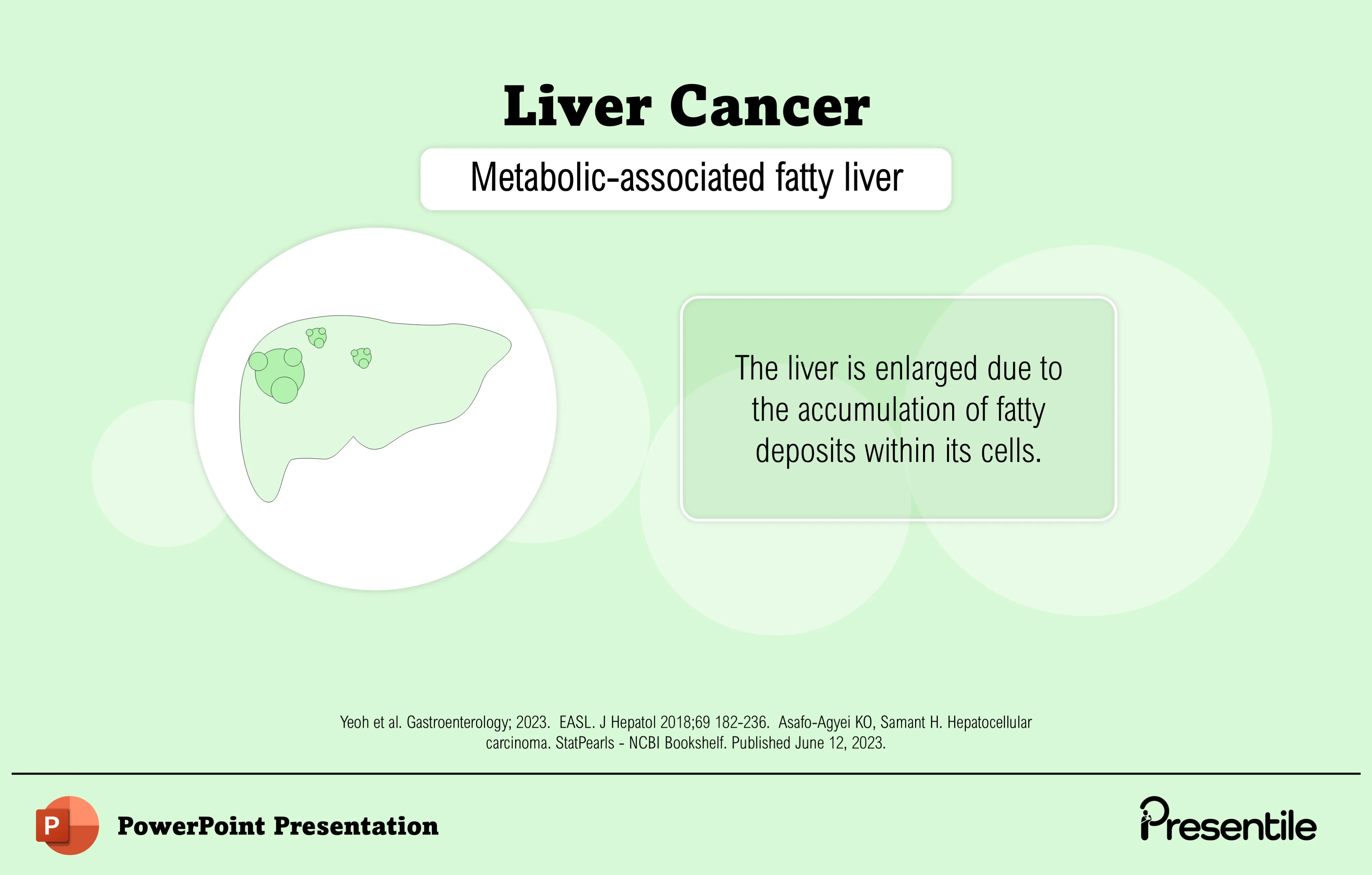
- This professionally designed PowerPoint slide offers a clear visual explanation of metabolic-associated fatty liver, the earliest stage in the progression of chronic liver disease and a key precursor to liver cancer.
- It illustrates how fat accumulates within liver cells, causing enlargement of the organ and marking the first step in liver damage.
Slide 9: Metabolic-Associated Steatohepatitis
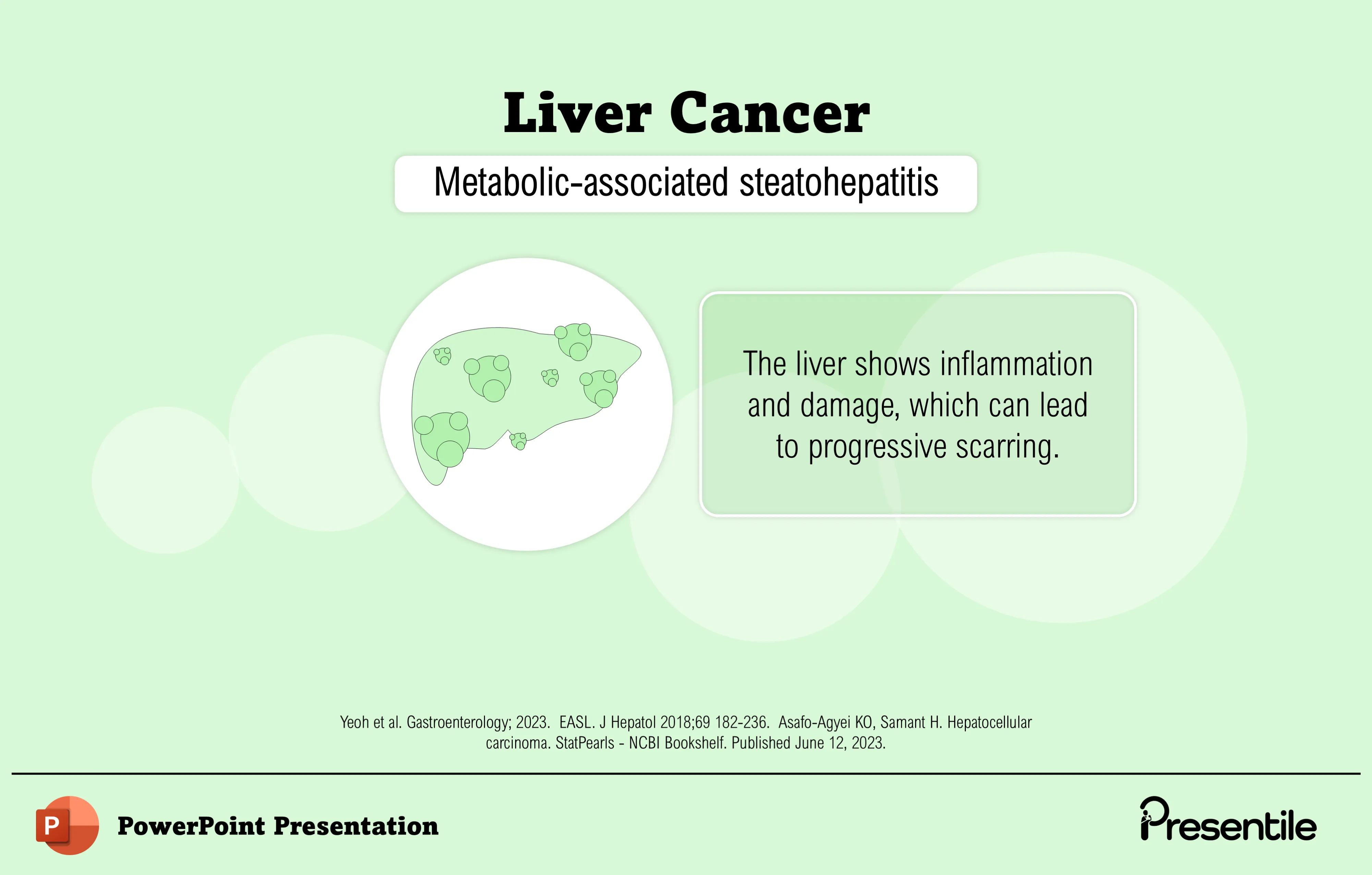
- This professionally designed PowerPoint slide provides a clear visual explanation of metabolic-associated steatohepatitis (MASH), the critical next stage after fatty liver in the progression of chronic liver disease.
- It shows how fat accumulation combines with inflammation and cellular injury, setting the stage for fibrosis—the scarring process that can lead to advanced liver damage.
Slide 10: Liver Fibrosis/Cirrhosis

- This professionally designed PowerPoint slide offers a clear visual explanation of liver fibrosis and cirrhosis, a critical stage in the progression of chronic liver disease toward hepatocellular carcinoma.
- It illustrates how excessive scarring irreversibly damages the liver’s structure, disrupts blood flow, and impairs function, dramatically increasing the risk of liver cancer.
Slide 11: Hepatocellular Carcinoma
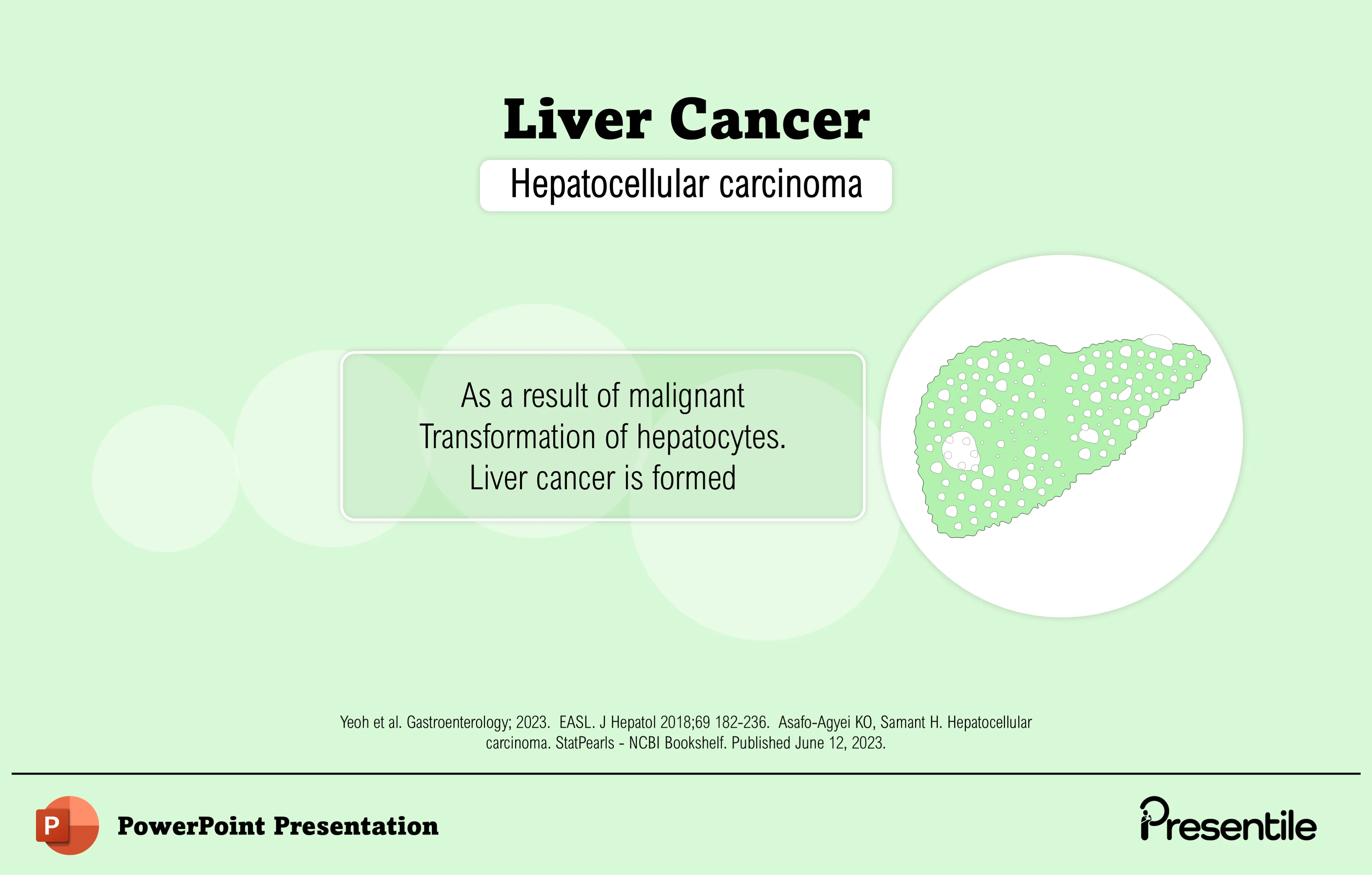
- This professionally designed PowerPoint slide delivers a clear visual explanation of hepatocellular carcinoma (HCC), the most common type of primary liver cancer.
- It illustrates how HCC develops through the malignant transformation of hepatocytes—the liver’s primary cells—often following chronic liver injury, especially cirrhosis, the strongest risk factor for its occurrence.
Slide 12: Liver Cancer - Risk Factors (Section Slide)
.webp)
- This slide serves as an effective and professional introduction to the risk factors of liver cancer.
- You can use this section divider to grab your audience's attention with a bold and clean warning icon, signaling the importance of the upcoming information.
Slide 13: Liver Cancer - Risk Factors

- This professionally designed PowerPoint slide provides a clear visual breakdown of the key risk factors for liver cancer, presented in an easy-to-understand icon-based format.
- It highlights major causes such as chronic Hepatitis B and Hepatitis C infection, which drive persistent liver inflammation; heavy, prolonged alcohol consumption, a leading cause of cirrhosis and liver injury; and inherited genetic conditions that increase individual susceptibility.
Slide 14: Liver Cancer - Diagnosis (Section Slide)
.webp)
- This slide provides a clear visual introduction to the diagnosis of liver cancer.
- You can use this professional slide to signal a new section of your presentation and introduce a discussion on how the disease is detected. The focused illustration of an ultrasound detecting a tumor in the liver makes this complex process easy to understand and prepares your audience for the specific diagnostic methods to be discussed.
Slide 15: Liver Cancer - Diagnostic Methods
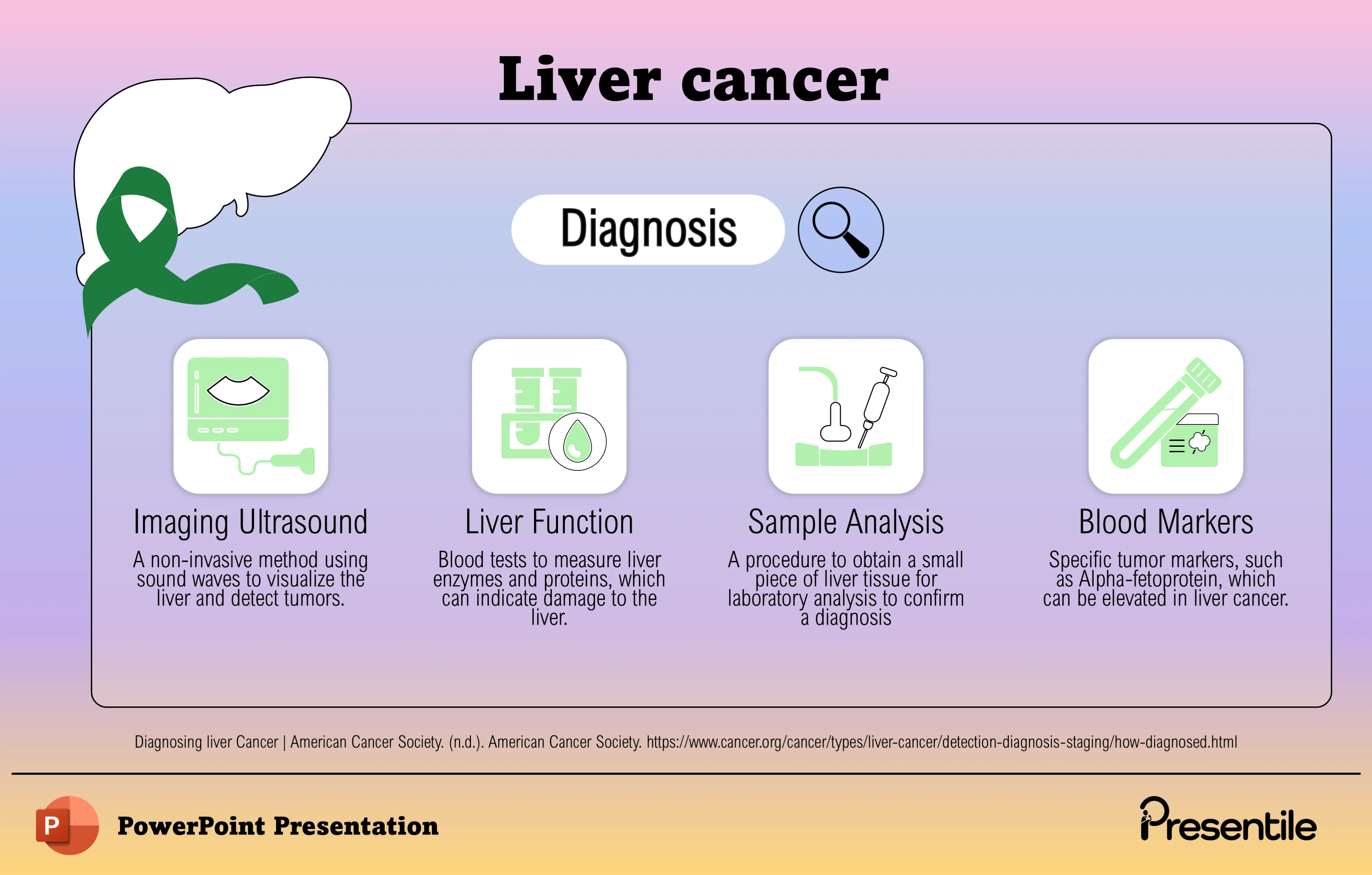
- This professionally designed PowerPoint slide presents a comprehensive overview of the four main methods used to diagnose liver cancer, arranged in a clear, icon-based format.
- It explains how ultrasound imaging serves as a non-invasive tool to detect and evaluate tumors, while liver function blood tests measure enzymes and proteins to identify possible damage.
- The slide also highlights the role of liver biopsy for definitive diagnosis through microscopic tissue analysis and the use of blood markers—such as alpha-fetoprotein—to support clinical suspicion and guide further evaluation.
Slide 16: Liver Cancer - Treatment (Section Slide)
.webp)
- This slide serves as an effective and professional introduction to the treatment of liver cancer.
- You can use this section divider to smoothly transition into the clinical management of the disease, preparing your audience for a detailed discussion on therapeutic approaches.
- The bold, clean design grabs your audience's attention and signals the beginning of a new, crucial section of the presentation.
Slide 17: Liver Cancer - Treatment Methods

- This professionally designed PowerPoint slide provides a comprehensive overview of the four main treatment methods for liver cancer, presented in a clear, icon-based format.
- It covers liver surgery to remove tumors, chemotherapy, targeted therapy, and the use of Tyrosine Kinase Inhibitors, which block cancer cell growth.
Slide 18: Liver Cancer - Prevention (Section Slide)
.webp)
- This slide provides a clean and professional introduction to the prevention of liver cancer.
- You can use this section divider to grab your audience's attention and seamlessly transition into the final topic of your presentation.
- The bold, clean design with the shield and liver icon makes it the perfect way to conclude your presentation on a proactive and positive note.
Slide 19: Liver Cancer - Prevention Methods
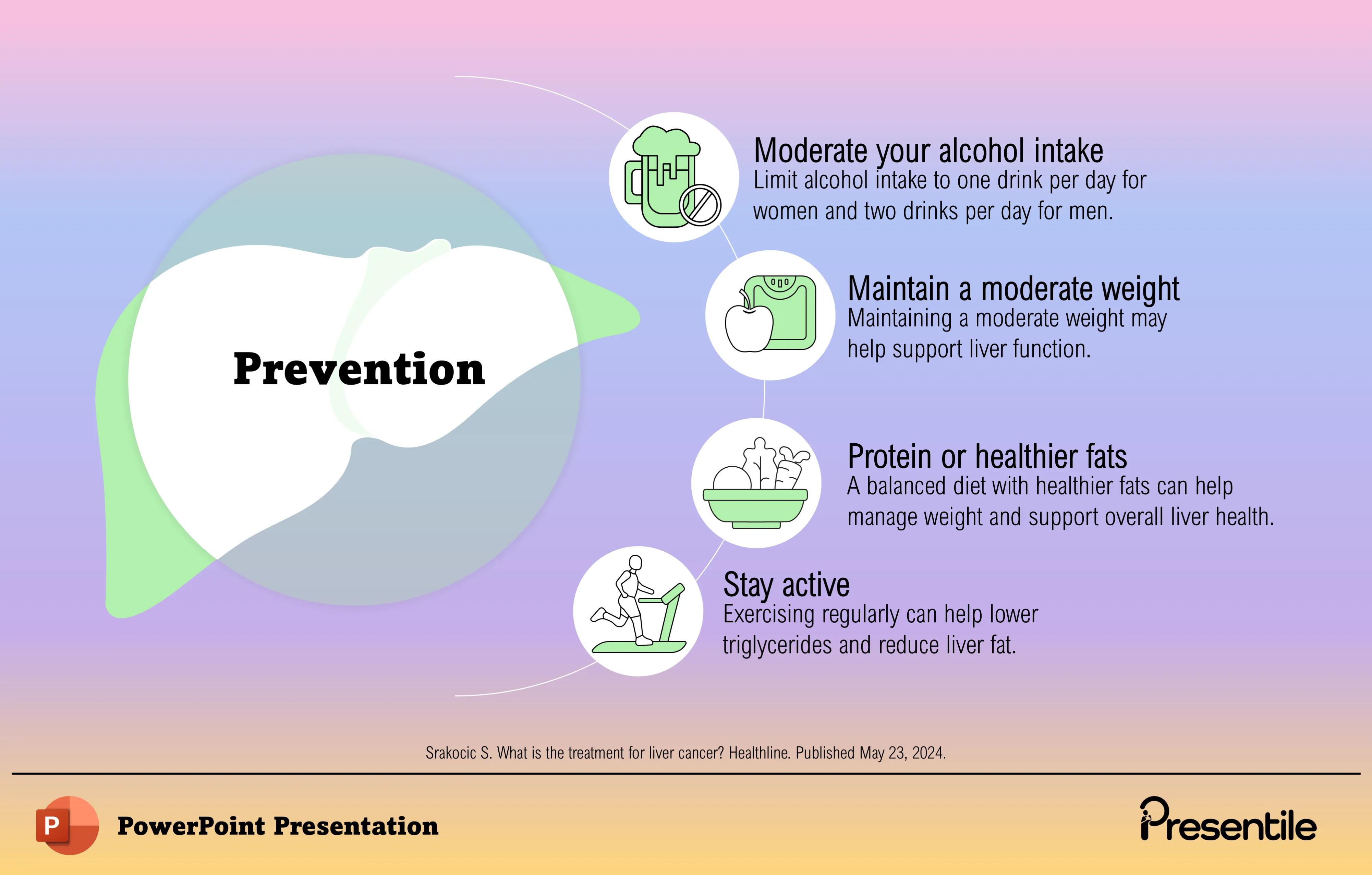
- This professionally designed PowerPoint slide offers a clear and actionable overview of liver cancer prevention strategies, presented in an organized, icon-based format.
- It highlights practical approaches such as moderating alcohol intake to prevent cirrhosis, maintaining a healthy weight through diet and exercise to reduce non-alcoholic fatty liver disease risk, eating a balanced diet rich in protein and healthy fats, and engaging in regular physical activity to lower liver fat and triglycerides.
Slide 20: Thank You

- This slide serves as an effective and professional conclusion to your presentation.
- You can use this slide to signal the end of your talk and provide a clear, memorable "Thank You" to your audience.
- The clean, professional design is perfect for transitioning into a Q&A session or a final summary of your key points.
Features of
Liver Cancer Presentation
- Fully editable in PowerPoint
- All graphics are in vector format
- Medically Referenced information and data
Specifications
 Slides count:
Slides count: Compatible with:Microsoft PowerPoint
Compatible with:Microsoft PowerPoint File type:PPTX
File type:PPTX Dimensions:16:9
Dimensions:16:9
Files Included
 Non-animated PowerPoint
Non-animated PowerPoint Animated PowerPoint File
Animated PowerPoint File Animated PowerPoint with Voice Over
Animated PowerPoint with Voice Over PDF Documents with presentation script
PDF Documents with presentation script
Elevate Your Work with Our Innovative Slides
Thank you! Your submission has been received!
Oops! Something went wrong while submitting the form.
No items found.



